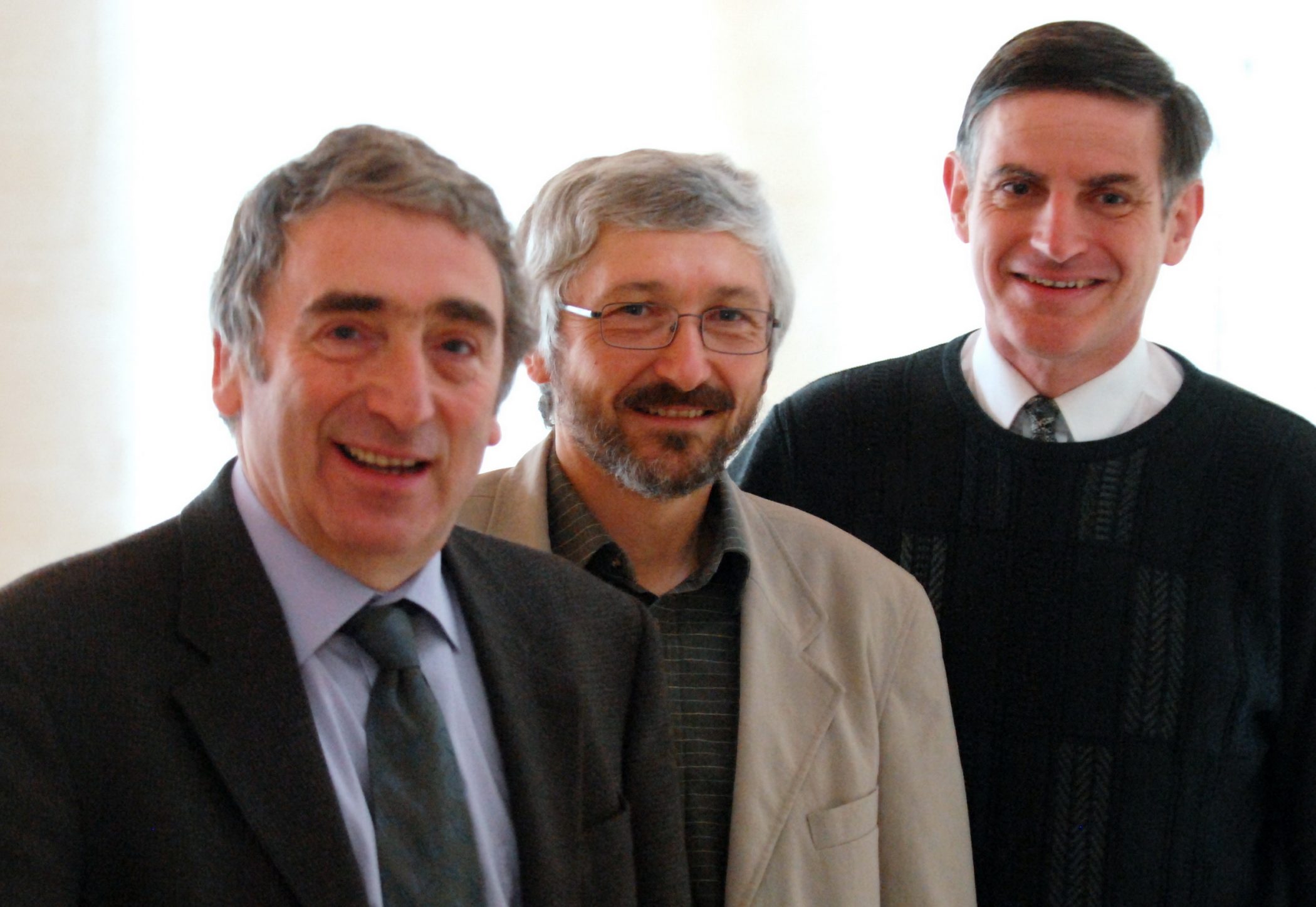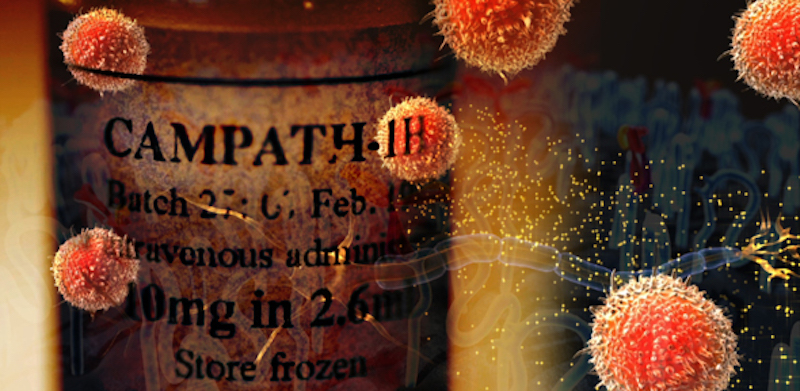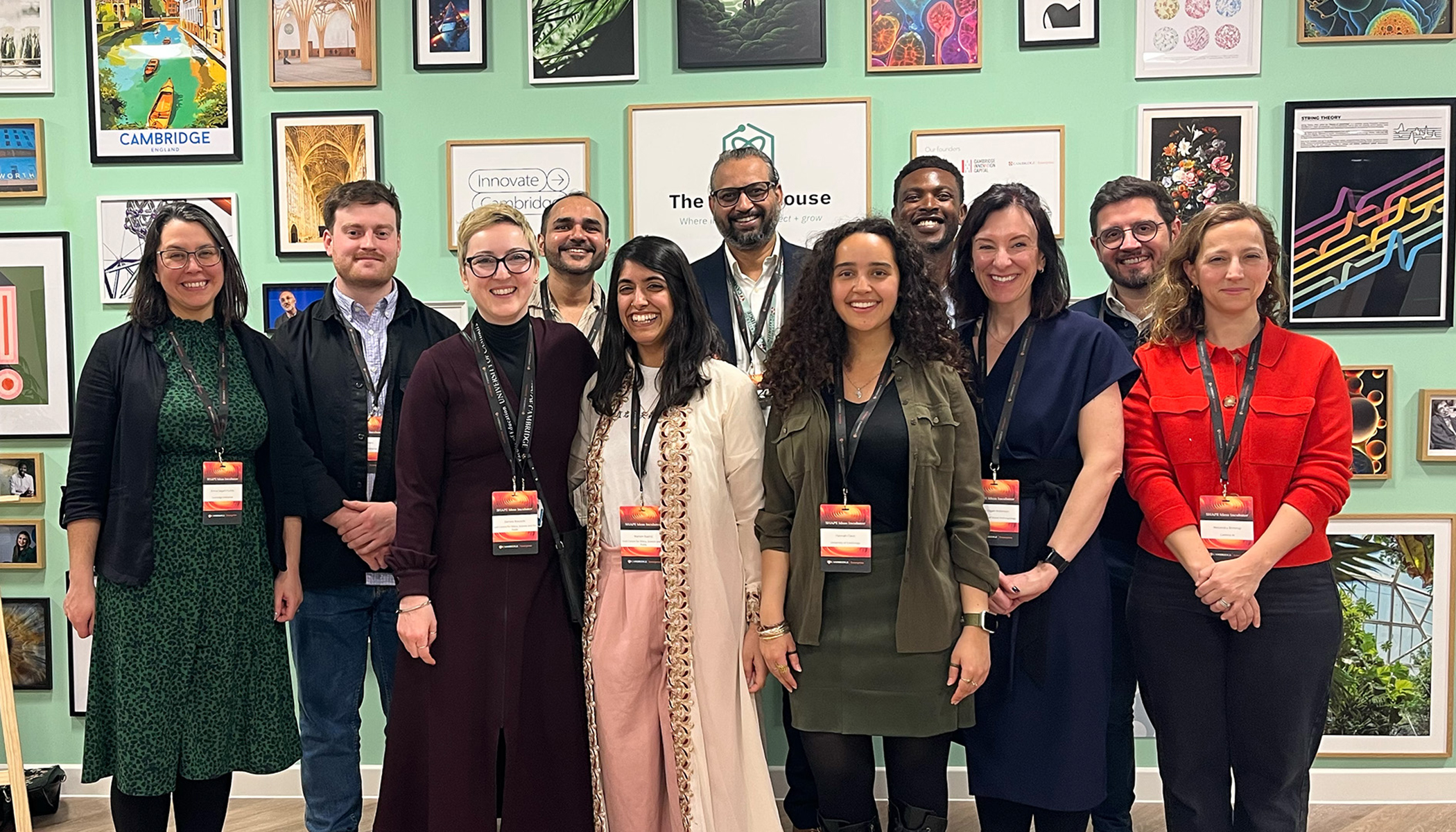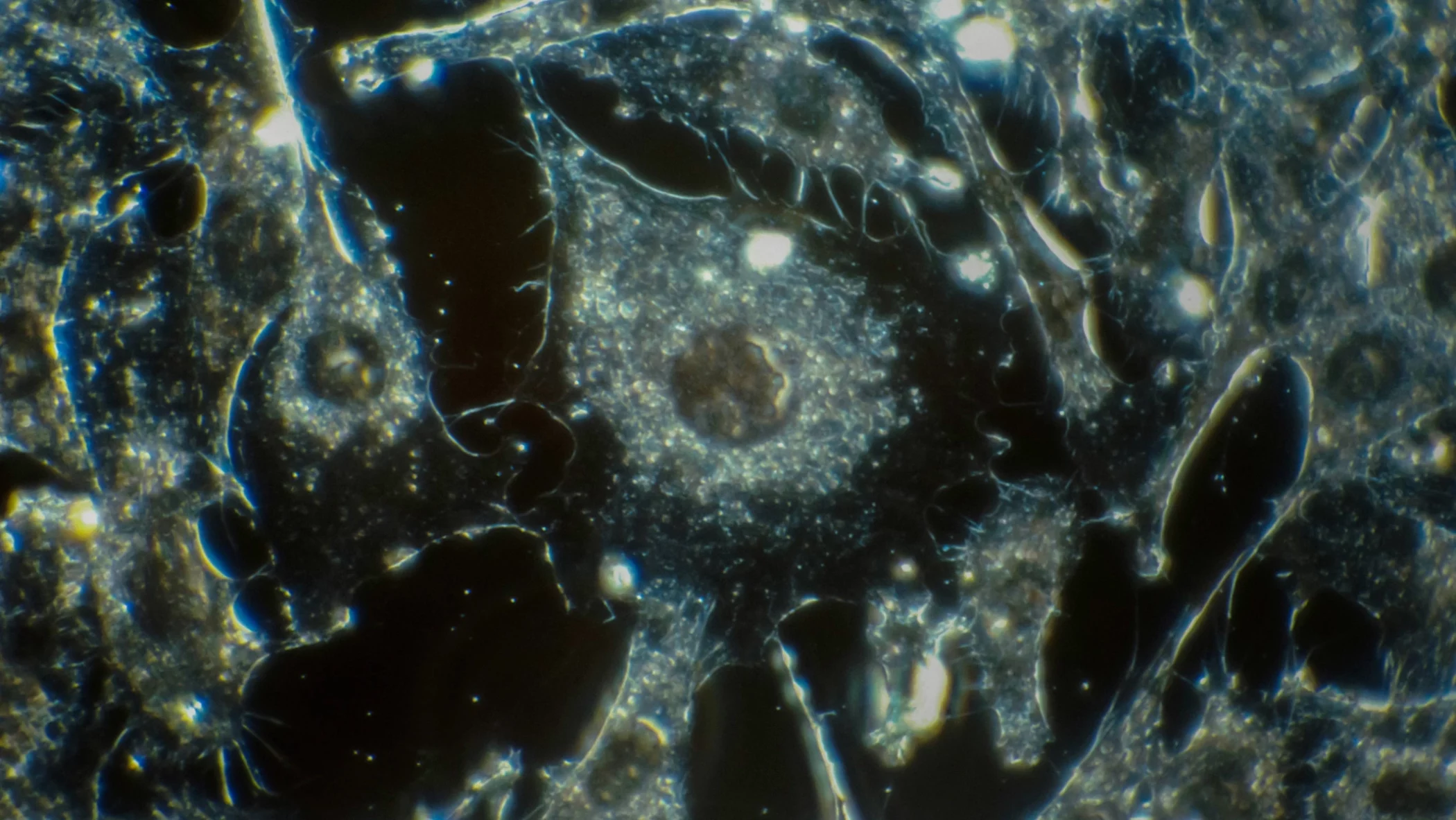Campath’s 10-Year Journey
10th anniversary storyThis story was included in our innovation showcase for our 10th anniversary celebrations in 2016 and is adapted from ‘A Tale of Two Innovations—Making an Impact’, which was written in 2009 by Dr Jane Bradbury.
The journey from basic research to successful drug
The path from innovation to impact can be long and complex. Here we describe the nearly 40-year history behind the development of Campath, a drug now used as a highly effective treatment for multiple sclerosis that has also been used successfully to fight lymphocytic leukaemia and non-Hodgkin lymphoma, as well as to avert rejection in transplants.
Campath’s journey is deeply rooted in fundamental research and illustrates the role it plays throughout the development of new innovations. “What universities are good at is fundamental research, and it is high-quality basic research that generates the really exciting ideas that are going to change the world,” says Dr Richard Jennings, former Deputy Director of Cambridge Enterprise.
That said, it takes tremendous time, money and commitment to progress a piece of basic research to a commercial product. The journey from lab to market can succeed only if there is long-term support from government funders, commercial partners and technology transfer offices. Campath’s story epitomises this long, complex route from laboratory to commercial success.
The journey started in 1979. Professor Herman Waldmann, then a lecturer in the Department of Pathology at the University of Cambridge and now Emeritus Professor of the Sir William Dunn School of Pathology, University of Oxford, was applying for his first Medical Research Council programme grant. “I was interested in understanding immunological tolerance,” recalls Waldmann, a process that was poorly understood at that time, as were many other aspects of the human immune system.
The immune system is a network of many cell types that protect the body from bacteria and other disease-causing organisms. When a pathogen infects cells, T and B lymphocytes, immune system cells that circulate in the blood, detect its presence by binding to pathogen-specific molecules, called antigens, and become activated. The activated T lymphocytes then either kill the pathogen-infected cells directly or help the activated B lymphocytes make antibodies, secreted proteins that recognise specific antigens. These antibodies coat the pathogens, labelling them for destruction by other immune system cells through processes that immunologists call effector mechanisms.
Your immune system usually ignores self antigens, molecules that are present in your own body. This lack of response is called tolerance. In 1978, says Waldmann, “people thought that to make a good immune response, lymphocytes had to cooperate with each other and that if there wasn’t good cooperation between lymphocytes, the default state was tolerance.”
One way to test this idea might be to reduce the number of lymphocytes in an experimental animal and then expose the animal to a new antigen. If this theory about tolerance were right, the animal should become tolerant to the antigen. But how could the number of lymphocytes in an animal be reduced?
The approach Waldmann took was to make an anti-lymphocyte antibody using a technique that had recently been developed by Dr César Milstein at the nearby Laboratory of Molecular Biology. By fusing myeloma cells (cancer cells that develop from B lymphocytes) with spleen cells, Milstein had created cell lines that indefinitely produced large amounts of a single antibody. These “monoclonal antibodies” were ideal for Waldmann’s experiment.
“The immediate medical applications of this experiment were very clear,” says Waldmann. “If it worked, it would provide a way to improve bone marrow transplants.” Used to aid cancer patients whose blood systems have been destroyed by radiotherapy, donated bone marrow provides stem cells that give the recipient a new blood system. Unfortunately donated bone marrow also contains mature lymphocytes, which can attack the patient.
Waldmann reasoned that by using a monoclonal antibody to remove mature lymphocytes from the donor marrow, potentially fatal graft-versus-host disease could be averted. Waldmann also saw his work as a way to investigate basic immunological mechanisms.
Campath antibodies and bone marrow transplants
Late in 1979, Waldmann and his team immunised a rat with human lymphocytes and fused its spleen cells with a rat myeloma cell line. Over Christmas, Waldmann isolated several antibody-producing cell lines from this Campath-1 (Campath stands for Cambridge Pathology) fusion. His team set to work to identify an antibody that could kill mature T lymphocytes without damaging the bone marrow stem cells.
In particular, the researchers looked for an antibody that could activate complement, one of the immune system’s effector mechanisms. The monoclonal antibody that best met these criteria was an IgM antibody. B lymphocytes can make several different types of antibody (isotypes), each of which behaves differently in terms of which immune effector mechanisms it interacts with to destroy pathogens. This particular IgM (Campath-1M) activated complement efficiently and almost completely eliminated T lymphocytes in test tubes.
The first bone marrow transplants that used Campath-1M for T-lymphocyte depletion were performed in the early 1980s. Donor bone marrow was treated with Campath-1M in test tubes, and the T-lymphocyte-depleted bone marrow was then injected into the graft recipients. This procedure successfully reduced the incidence of graft-versus-host disease, but a new problem soon became evident. Some of the bone marrow recipients rejected the transplant. Their immune systems had recognised the marrow as foreign, even though the patients had been given drugs before the transplant to suppress their immune responses. Clearly, a better method was needed to suppress the patient’s immune response.
An obvious way to do this was to treat both the donor bone marrow and the transplant recipient with a T-lymphocyte-depleting antibody. Because the researchers knew that Campath-1M worked poorly in patients, they returned to the laboratory to find another antibody isotype that might be more effective. Their results suggested that an IgG2b antibody was likely to work best. Unfortunately, none of the antibodies produced in the Campath-1 fusion had this isotype.
Monoclonal-antibody-producing cell lines sometimes, however, spontaneously start making antibodies of a different isotype. So, the researchers painstakingly screened a cell line that was making an IgG2a antibody until they found one cell that had switched to making an IgG2b antibody. This they dubbed Campath-1G. Like the original Campath-1M (and like Campath-1H), Campath-1G binds to a molecule called CD52 that is present on lymphocytes and some other human cells.
Campath-1G and Campath-1H go into patients
“Once we knew we had an antibody that worked in patients, we started to talk to a variety of clinicians who might be interested in using an anti-lymphocyte antibody,” recalls Waldmann. Some of these clinicians were treating patients who had lymphocytic leukaemia, a blood cancer in which lymphocytes replicate uncontrollably. Two patients with this type of cancer were duly treated with Campath-1G and initially responded well. Unfortunately both patients subsequently relapsed. One patient’s immune system had recognised Campath-1G—a rat antibody—as foreign and destroyed it.
A more nearly-human antibody, which would be ignored by the immune system, was needed. Fortuitously, another Cambridge scientist, Professor Sir Greg Winter, had just developed a way to “humanise” antibodies. Humanisation is the replacement of some regions in an animal antibody with the equivalent human regions. The animal regions that determine which antigen the antibody recognises are retained in humanised antibodies. Dr Mike Clark, who had joined Waldmann’s laboratory in 1981, started to make a set of fully and partly humanised antibodies from Campath-1G and, together with other team members, tried to determine which human isotypes would work in patients. Campath-1H, a humanised IgG1, was the result of all this basic research. “These days, we think that a partly humanised antibody that retained some more of the rat regions would probably have worked just as well,” says Clark, who retired as Reader in Therapeutic Immunology in the Department of Pathology in 2014.
Campath-1H was very successful for the treatment of lymphocytic leukaemia and non-Hodgkin lymphoma as well as for use in bone marrow and solid organ transplants. Clinicians started to use it to treat several autoimmune diseases, including vasculitis, rheumatoid arthritis and MS. The clinical-grade material needed for these studies was produced in the Therapeutic Antibody Centre (TAC) that Waldmann set up in Cambridge in 1990 with Professor Geoff Hale, a biochemist who had joined Waldmann’s group at the beginning of the Campath-1H story; went on to the Dunn School of Pathology, Oxford, and now is a freelance scientist, consultant and company director. The TAC moved to Oxford in 1995. “Without Geoff’s critical contribution and the support of both Cambridge and Oxford University,” says Waldmann, “we would not have been able to initiate many of these studies, including our long-standing collaboration with Alastair Compston in his work on MS.”

Image from left to right: Herman Waldmann, Mike Clark, Geoff Hale
Pharmaceutical company involvement
Because the development of drugs for clinical use is a long, expensive and highly regulated process, the involvement of pharmaceutical companies is essential. In the early 1980s, the Cambridge researchers assigned the rights for the Campath-1 cell lines to the British Technology Group, a government body set up to to commercialise publicly funded research and is now BTG plc, an international specialist healthcare company. In 1985, BTG licensed Campath-1M to Wellcome Biotech, a subsidiary of the Wellcome Foundation. “Many people were very sceptical in the mid-1980s about the commercial future of antibodies and other biotech drugs, but Wellcome was excited by the potential of this new area,” says Jennings.
When the basic research being undertaken by Waldmann’s team suggested that Campath-1G and Campath-1H were more likely to have a clinical future than Campath-1M, these antibodies were also licensed to Wellcome Biotech. Indeed, once Campath-1H had been handed over, the company abandoned its work on the earlier antibodies and started a programme of clinical trials of Campath-1H in rheumatoid arthritis, leukaemia and lymphoma. Around this time, Campath-1H was given the generic name Alemtuzumab.
Meanwhile, the academic scientists continued with their basic research, refining and extending their understanding of how Campath was working in various diseases by working closely with the physicians giving the antibody to patients. This research was helped along by the development of new molecular techniques and by improved understanding of the human immune system.
Then, in 1995, Wellcome (which merged with Glaxo that year to become Glaxo-Wellcome) decided to abandon its development of Campath, fearing it would not have the billion-dollar market they had hoped for. Although the antibody worked well in some types of leukaemia, it did not work in all types. In the rheumatoid arthritis trials Campath, or Alemtuzumab as it was now known, had permanently suppressed patients’ immune systems.
The decision was deeply disappointing for Waldmann and his colleagues, who believed strongly in the clinical potential of Alemtuzumab. “We looked at things from a different point of view,” says Waldmann. “As academic scientists, when Campath-1H caused unexpected side effects or did not work as well as expected, our response was to look at the evidence, figure out what had gone wrong and find ways to put it right rather than giving up.”
In 1997, after protracted negotiations with BTG and Glaxo-Wellcome, LeukoSite Inc. took on the license to develop Alemtuzumab. LeukoSite, which merged with Millennium Pharmaceuticals in 1999, partnered with ILEX Oncology to complete the development and obtain US approval in 2001 for Alemtuzumab to be used for the treatment of B-cell chronic lymphocytic leukaemia (CLL) in patients who had failed to respond to conventional chemotherapy. The license for Alemtuzumab was then transferred to ILEX Oncology before, finally, in 2004, Genzyme Corporation acquired ILEX Oncology and the production rights to Campath-1H. In 2011 Genzyme was acquired by Sanofi, creating Sanofi Genzyme.
“Campath-1H had a particularly tortuous commercial history,” says Mark Enyedy, who spent 25 years at Genzyme and is now CEO of ImmunoGen, Inc. “I think the many changes of commercial support for this product impeded the realisation of this drug’s commercial potential even though products like this always take an enormous time to develop.”
MS: Campath-1H’s new market
The revenue from the use of Campath-1H, or Alemtuzumab, for the treatment of CLL has been considerable. It may, however, eventually be dwarfed by revenue from the use of Alemtuzumab to treat early relapsing–remitting MS. As in other diseases, the development of Alemtuzumab (or Lemtrada®, its new brand name) for the treatment of MS has relied on academic researchers able to discern how Campath-1H is working in patients and how to improve it.
MS is an inflammatory neurological disease caused by the immune system attacking myelin, the substance that forms an insulating sheath around the nerve fibres of the brain and spinal cord. When the myelin sheath is damaged, the electrical messages that travel along the nerves between the brain and the body are impeded and disrupted.
The majority of MS sufferers initially have the relapsing–remitting form of the disease. The symptoms (which include muscle spasms and stiffness, tremors, bladder and bowel control problems, and pain) occur episodically, followed by periods of remission. Relapses, which can occur at any time, vary in length and severity. Most people who have relapsing–remitting MS eventually develop secondary progressive MS in which the occurrence of relapses wanes but overall disability slowly increases.
Early attempts to treat MS
By the late 1980s, it was becoming clear that MS was an autoimmune disease in which activated T lymphocytes move into the central nervous system (CNS) and damage myelin. As Professor Alastair Compston (Professor Emeritus of Neurology and Head of the Department of Clinical Neurosciences at the University of Cambridge) explains, “We began to wonder whether we could help patients with MS by preventing the movement of activated lymphocytes from the bloodstream into the brain.”
Treatment with Alemtuzumab looked like one way that this could be achieved. In 1991, Compston initiated a long collaboration with Waldmann and his team by trying this approach in a woman who had developed MS some years earlier. “At that time, there were no licensed treatments for MS, and this individual seemed to be facing a particularly grim future,” says Compston. “Alarmingly, she actually got much worse for a day or two after receiving Campath-1H but then picked up and remained very well for some years. She even seemed to get back some of her lost functions.”
Keeping in close contact with Waldmann’s team, Compston and colleagues carefully followed the progress of their patient for about 18 months before treating another six people. “By 1994, we had satisfied ourselves that Campath-1H treatment could stop the development of new inflammatory lesions in the brain,” says Compston “[And] it seemed as though our patients had fewer new attacks after the treatment.”
By 1999, Compston and a clinical trainee, Reverend Professor Alasdair Coles, had treated 27 patients, all of whom had already entered the secondary progressive stage of MS. “We paused then to analyse our results,” says Compston.
“We realised that, although we had stopped disease activity in terms of new inflammatory brain lesions and had reduced the number of attacks that people were having, most of our patients were continuing to deteriorate.” The problems that the patients had when they started Campath-1H treatment were slowly progressing. This observation puzzled the researchers. If MS is an inflammatory autoimmune disease, why was Alemtuzumab treatment failing to help people in the progressive phase of the disease even though the treatment seemed to turn off inflammation?
The answer to this conundrum, the researchers realised, is that there are two separate processes going on in MS: inflammation and degeneration. Inflammation causes the attacks in relapsing–remitting MS but also triggers nerve degeneration. Eventually, the degenerative component of the disease gains a momentum of its own and continues even in the absence of inflammation, which results in slow progression and the accumulation of disabilities that don’t get better. “Until we used Campath-1H in patients, this separation between inflammation and degeneration was not appreciated, but its implications were obvious,” says Compston. “If this drug were going to be of any use to people with MS, we would have to use it much earlier in the disease process than we had so far.”
Campath-1H for the treatment of relapsing–remitting MS
Compston and Coles now began to treat some of their patients with relapsing–remitting MS with Campath. As before, the treatment almost completely stopped new attacks occurring but, in addition, many of these patients actually began to get better. Their various disabilities began to improve. It was time to take Campath into formal clinical trials to prove the drug’s efficacy and to prepare the way for marketing the drug for the treatment of MS.
With the support of ILEX Oncology (and, from 2004, of Genzyme), a Phase II clinical trial was started in December 2002. Patients enrolled into the trial had to meet strict entry criteria and were treated with up to three annual doses of Campath. The effects of the drug were measured three years after the initial treatment and, unusually for a Phase II trial, its effects were compared with the effects of another drug, interferon beta-1a, then the gold standard treatment for MS. “We set the bar high in this trial,” says Enyedy. “Most studies of treatments for MS compare the new treatment with a placebo and only last a year.” Compston describes Genzyme as “fantastically committed to the development of Campath-1H for use in MS”.
The results of the trial, which were published in 2008 in the New England Journal of Medicine, showed that there were 70 per cent fewer relapses and that the risk of accumulated disability was 70 per cent lower among the patients receiving Alemtuzumab than among those treated with Interferon Beta-1a. Furthermore, as in the patients treated before the trial started, the disability score of patients treated with Alemtuzumab actually improved; by contrast, it worsened in the patients given Interferon Beta-1a.
The end of a long journey had finally been reached. In May 2014, Alemtuzumab was approved by the National Institute for Health and Care Excellence for the treatment of relapsing–remitting multiple sclerosis, and in November of the same year it was approved by the US Food and Drug Administration. The clinical trials proved the drug reduced disease activity, limited the accumulation of further disability over time and might allow some existing damage to recover.











